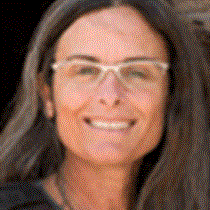Isla Carmen
This morning our wake-up call was at the civilized hour of 7am. But the excitement was immediate as the call included “bottlenose dolphins on the bow.” As we arrived on deck we were greeted by “dolphin aerobics,” including one stunning backward flip just off the bow. We broke away from this group just before breakfast, but no sooner than taking our last sip of breakfast coffee, another call from the bow announced a large group of long-beaked common dolphins. Once again, camera’s clicked away and squeals could be heard as we observed this active group, which included many young dolphins.
We were just off Isla Carmen, with Isla’s Catalina and Monserrat forming a triangle around us. South of us heavy clouds passed across the sky and both sunlight and rain could be seen in the distance dramatically streaming down from above. We headed towards the town of Loreto, cruising below the beautiful Sierra de la Giganta mountains.
After seeing so many dolphins, Jack gave us a morning video presentation on the art of photographing dolphins. The video helps us to learn more about their behavior and how to capture them better on film or pixels. Later, Ralph gave his presentation on Creativity and Your Camera – Part 2. By the time lunch is announced, we are filled with many new ideas for ways to take better photographs.
We anchor offshore at Loreto, the original capitol of Baja California founded in 1535 by Hernan Cortez and the sight of the first California mission (founded in 1697). Over the mission doorway it says, “Cabeza y Madre de las Misiones de Baja y Alta California.” This translates to say that it is the head and mother of all Southern and Northern California missions. A series of floods, hurricanes and earthquakes distressed this mission repeatedly over the years and finally in the early 1800’s, the capitol was moved to La Paz.
Today our activities were much milder relative to the history of Loreto as we explored the town in many different ways. Today is Palm Sunday and it was a very quiet time to visit Loreto. Many of us visited the mission museum. The bird watchers headed off to a river mouth on the south side of town spotting many birds including a green heron. The more prevalent shop watchers explored the shopping options. And of course, the photographers took advantage of the opportunities to create new images of diving pelicans, Mexican architecture, and the regional lifestyle.
We returned to the ship for our evening sail under a full moon towards Isla Catalina.
This morning our wake-up call was at the civilized hour of 7am. But the excitement was immediate as the call included “bottlenose dolphins on the bow.” As we arrived on deck we were greeted by “dolphin aerobics,” including one stunning backward flip just off the bow. We broke away from this group just before breakfast, but no sooner than taking our last sip of breakfast coffee, another call from the bow announced a large group of long-beaked common dolphins. Once again, camera’s clicked away and squeals could be heard as we observed this active group, which included many young dolphins.
We were just off Isla Carmen, with Isla’s Catalina and Monserrat forming a triangle around us. South of us heavy clouds passed across the sky and both sunlight and rain could be seen in the distance dramatically streaming down from above. We headed towards the town of Loreto, cruising below the beautiful Sierra de la Giganta mountains.
After seeing so many dolphins, Jack gave us a morning video presentation on the art of photographing dolphins. The video helps us to learn more about their behavior and how to capture them better on film or pixels. Later, Ralph gave his presentation on Creativity and Your Camera – Part 2. By the time lunch is announced, we are filled with many new ideas for ways to take better photographs.
We anchor offshore at Loreto, the original capitol of Baja California founded in 1535 by Hernan Cortez and the sight of the first California mission (founded in 1697). Over the mission doorway it says, “Cabeza y Madre de las Misiones de Baja y Alta California.” This translates to say that it is the head and mother of all Southern and Northern California missions. A series of floods, hurricanes and earthquakes distressed this mission repeatedly over the years and finally in the early 1800’s, the capitol was moved to La Paz.
Today our activities were much milder relative to the history of Loreto as we explored the town in many different ways. Today is Palm Sunday and it was a very quiet time to visit Loreto. Many of us visited the mission museum. The bird watchers headed off to a river mouth on the south side of town spotting many birds including a green heron. The more prevalent shop watchers explored the shopping options. And of course, the photographers took advantage of the opportunities to create new images of diving pelicans, Mexican architecture, and the regional lifestyle.
We returned to the ship for our evening sail under a full moon towards Isla Catalina.




